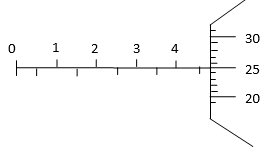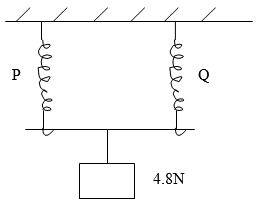Physics Form 2 End Term 2 Exams 2021 with Marking Schemes
- Explain the following: (2mks)
- Wet floors and wet roads are dangerous to walk on.
- Racing cyclist usually wears smooth tight clothes.
- Convert each of the following from Kelvin to oC. (2mks)
- 0 K
- 167 K.
- A mixture consists of 40cm3 of water and 60cm3 of liquid x. If the densities of water and liquid x are 1.0g/cm3 and 0.8g/cm3 respectively. Calculate the density of the mixture. (3mks)
- The air pressure at the base of a mountain is 75.0cm of mercury while at the top 60.0cm of mercury. Given that the average density of air is 1.25kg/cm3 and the density 13600kg/m3, calculate the height of the mountain. (4mks)
-
- Define the term Brownian motion and its cause. (2mks)
- Differentiate the three states of matter with relation to intermolecular space and intermolecular force. (3mks)
-
- Define the term temperature and state its SI unit. (2mks)
- Explain why in construction, concrete beams are reinforced with steel. (2mks)
- Explain three effects of anomalous expansion of water. (3mks)
- State there advantages of mercury over alcohol as thermometric liquid.(3mks)
-
- State the three modes of heat transfer. (3mks)
- State three factors affecting thermal conductivity. (3mks)
- Explain why the ventilators for a room are put near the roof and not near the floor. (2mks)
- State the laws of reflection. (2mks)
- Explain two dangers of electrostatics. (2mks)
- State two applications of electrostatics. (2mks)
- List three methods of demagnetizing a permanent magnet. (3mks)
- What is the reading indicated by the micrometer screw gauge below. (3mks)
- A uniform metal rod of length 80cm and mass 3.2kg is supported horizontally by the two vertical spring balances C and D. Balance C is 20cm from one end while balance D is 30cm from the other end. Find the reading on each balance. (3mks)
- A convex mirror of focal length 9cm produces an image on its axis 6cm from the mirror. Determine the position of the object. (3mks)
- Explain how an electric bell works. (3mks)
- Two very light identical springs P and Q are arranged as shown below.
A weight of 4.8N is supported by the spring. Given that each spring has a spring constant of 10N/cm; determine the total extension of springs P and Q. (3mks) - Differentiate between transverse waves and longitudinal waves.(2mks)
- The figure below shows a wave form in a string.
Given that the speed of the wave is 10m/s. With reference to this wave motion, determine;- Wavelength. (1mk)
- Amplitude. (1mk)
- Frequency. (2mks)
- Period (2mks)
- What is the relationship connecting frequency, wavelength and velocity of sound in air? (1mk)
- A person standing 49.5m from the foot of a cliff claps his hands and hears an echo 0.3 seconds later. Calculate the velocity of the sound in air. (3mks)
Marking Scheme
- Explain the following: (2mks)
- Wet floors and wet roads are dangerous to walk on.
Water reduces friction. - Racing cyclist usually wears smooth tight clothes.
To reduce resistance due to air motion.
- Wet floors and wet roads are dangerous to walk on.
- Convert each of the following from Kelvin to oC. (2mks)
- 0 K
0 – 273 = -273oC - 167 K.
167K – 273K = -110oC.
- 0 K
- A mixture consists of 40cm3 of water and 60cm3 of liquid x. If the densities of water and liquid x are 1.0g/cm3 and 0.8g/cm3 respectively. Calculate the density of the mixture. (3mks)
- The air pressure at the base of a mountain is 75.0cm of mercury while at the top 60.0cm of mercury. Given that the average density of air is 1.25kg/cm3 and the density 13600kg/m3, calculate the height of the mountain. (4mks)
Pressure at top of mountain.
0.60 x 13600 x 10
= 81600N/m2
Pressure at base of mountain
0.75 x 13600 x 10
= 102000N/m2
Pressure diff. 102000 – 81600 = 20400N/m2
Pressure due to column of air – 20400 N/m2
ha φag = 20400
ha =20400/(1.25×10)=1632m -
- Define Brownian motion and its cause. (2mks)
This is the constant random movement of particles caused by the uneven bombardment / collisions of gas or liquid particles. - Differentiate the three states of matter with relation to intermolecular space and intermolecular force. (3mks)
In solids particles are closely paused therefore the intermolecular space is negligible and has strong intermolecular force. Liquids have a small intermolecular space and force is not strong as in solids. Gases have very weak intermolecular force therefore intermolecular space is wide.
- Define Brownian motion and its cause. (2mks)
-
- Define temperature. (2mks)
This is the degree (extent) of hotness or coldness of a body on some chosen scale. - State the reason why in construction, concrete beams are reinforced with steel. (2mks)
They are reinforced because they expand at the same rate and have almost the same linear expansivity. - Explain three effects of anomalous expansion of water. (3mks)
- Weathering of rocks.
- Freezing of lakes and ponds.
- Bursting of water pipes.
- Define temperature. (2mks)
- State the advantages of mercury over alcohol as thermometric liquid.(3mks)
- Can measure high temperatures of upto 357oC
- Is a good thermal conductor.
- Expand regularly.
- Does not wet glass.
- Is easily visible.
-
- State the three modes of heat transfer. (3mks)
- convection.
- radiation
- conduction
- State three factors affecting thermal conductivity. (3mks)
- Temperature difference between ends of conductor.
- Length of the conductor.
- Cross-section area of conductor.
- Nature of the material.
- Explain why the ventilators for a room are put near the roof and not near the floor. (2mks)
- Air expelled by the room occupants is warm and less dense. It rises up and through the ventilation holes. Cool fresh air flows into the room to replace the risen warm air.
- State the three modes of heat transfer. (3mks)
- State the laws of reflection. (2mks)
- Angle of incidence i equals to the angle of reflection r.
- The incident ray, the reflected ray and the normal at the point of incidence all lie on the same plane.
- Explain two dangers of electrostatics. (2mks)
- Sparks and fires.
- Electric shock.
- Lightining.
- State two applications of electrostatics. (2mks)
- Electrostatic precipitator
- Spray painting
- Photocopier.
- List three methods of demagnetizing a permanent magnet. (3mks)
- Hammering
- Heating
- Electrical method.
- What is the reading indicated by the micrometer screw gauge below.(3mks)
Sleeve reading 4.50mm
Thimble scale =25/100
= 0.25mm
Reading = 4.50 + 0.25
= 4.75mm - A uniform metal rod of length 80cm and mass 3.2kg is supported horizontally by the two vertical spring balances C and D. Balance C is 20cm from one end while balance D is 30cm from the other end. Find the reading on each balance. (3mks)
When pivot at C:
Then C.M = (30 x 32) Ncm
A.C.M = 50D
C.M = A.C.M => 960/50=50D/50
D = 19.2N
C + D = 32N
C = 32 – 19.2
= 12.8N
Reading on C = 12.8N
Reading on D = 19.2N - A convex mirror of focal length 9cm produces an image on its axis 6cm from the mirror. Determine the position of the object. (3mks)
f = -9cm (Convex mirror)
v = -6cm
1/f=1/u+1/v
1/(-9)=1/6+1/u
1/u=1/6+(-1)/9=1/18
u = +18cm object is real and 18cm in front of the mirror. - Explain how an electric bell works. (3mks)
When circuit is closed, electromagnet induces magnetism in the soft iron strip, which then attracted to the poles of the electromagnet. The hammer attached to the armature thus strikes the gong. - Two very light identical springs P and Q are arranged as shown below.
A weight of 4.8N is supported by the spring. Given that each spring has a spring constant of 10N/cm; determine the total extension of springs P and Q. (3mks)
Soln
Kp = nK1
= 2 x 10N/cm
= 20N/cm
F = ke => e = F/k=(4.8N)/(20N/cm)
= 0.24cm. - Differentiate between transverse waves and longitudinal waves.(2mks)
Transverse waves, the vibration of the particles is a right angles to the direction of wave travel while longitudinal waves, the vibration of the particles is in a direction parallel to the direction of the wave travel. - The figure below shows a wave form in a string.
Given that the speed of the wave is 10m/s. With reference to this wave motion, determine;- Wavelength. (1mk)
= 40cm. - Amplitude. (1mk)
= 5cm - Frequency. (2mks)
v=λf
f=v/λ=(10m/s)/(40×(10)^(-2) m)
=25Hz - Period of the oscillation. (2mks)
T=1/f
1/25
= 0.04s
- Wavelength. (1mk)
- What is the relationship connecting frequency, wavelength and velocity of sound in air? (1mk)
v=λf - A person standing 49.5m from the foot of a cliff claps his hands and hears an echo 0.3 seconds later. Calculate the velocity of the sound in air. (3mks)
T=v2d/s=(49.5×2)/(0.3)=s
v=330m/s
Join our whatsapp group for latest updates
Tap Here to Download for 50/-
Get on WhatsApp for 50/-
Download Physics Form 2 Questions and Answers - End Term 2 Exams 2021.
Tap Here to Download for 50/-
Get on WhatsApp for 50/-
Why download?
- ✔ To read offline at any time.
- ✔ To Print at your convenience
- ✔ Share Easily with Friends / Students




